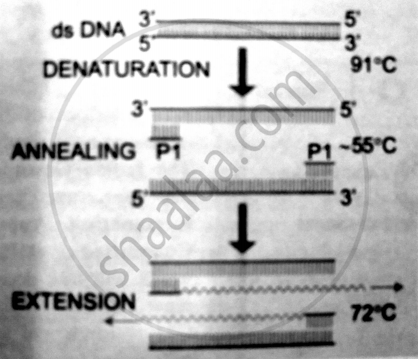Advertisements
Advertisements
Question
What does PCR stand for? Describe the different steps of PCR
Solution
PCR stands for Polymerase Chain Reaction:
Basic requirements for PCR technique are :
1) A DNA segment (100-35, 000 bp in length) be amplified.
2) Primers (forward and reverse) which are synthetic oligonucleotides of 17-30 nucleotide. They
are complementary to the sequence present on the desired DNA segment.
3) Four types of deoxyribonucleotides (dATP, dCTP, dGTP, dTTP). They are collectively called
dNTPs
4)A thermostable DNA polymerase, that can withstand up to 94°C. Usually, Taq polymerase isolated from bacterium Thermus aquaticus is used.

The three essential steps for PCR technique are :
1) Heat denaturation: This step involves heating of DNA at about 91°C. The heating breaks the hydrogen bonds to make ssDNA. The DNA molecule with more G-C pairs needs the higher
temperature.
2)Annealing: It is pairing of primers to the ssDNA segment. The primer has to be designed as per the requirement. this step requires temperature at about 55°C.
3) Polymerisation: The temperature is raised to 72°C. The Taq polymerase adds dNTPs behind
the primer on the ssDNA
These three steps constitute one cycle of the reaction. The process is carried out for about 28-30 cycles beyond which its reliability decreases.
APPEARS IN
RELATED QUESTIONS
State the role of DNA ligase in biotechnology.
One of the major contributions of biotechnology is to develop pest-resistant varieties of cotton plants. Explain how it has been made possible.
What is the cell that receives a recombinant gene called?
Explain the properties of a good or ideal cloning vector for rDNA technology.
Match the List I with List II and List ill. Select the correct option.
| List I | List II | List ill | |||
| i. | Hind III | a. | Agarose ge | 1. | Six base pairs |
| ii. | pBR322 | b. | Agrobacterium | 2. | Selectable marke |
| iii. | T-DNA | c. | Ampicillin | 3. | Elution |
| iv. | DNA | d. | Recognition sequenc | 4. | Transgenic plant |
From the following identify the methods of electrophoresis.
____________ cuts the DNA within the specific positions.
Following are the four statements regarding separation of DNA fragments using Gel electrophoresis. Identify the INCORRECT statements.
i. DNA is negatively charged molecule and so it is loaded on gel towards the Anode terminal.
ii. DNA fragments travel along the surface of the gel whose concentration does not affect movement of DNA.
iii. Smaller the size of DNA fragment, larger is the distance it travels through it.
iv. Pure DNA can be visualized directly by exposing to UV radiation.
The rDNA technology has provided a method to control the nematode parasite Meloidogyne incognita. Explain the principle involved in this technique.
Both a wine maker and a molecular biologist who had developed a recombinant vaccine claim to be biotechnologists. Who in your opinion is correct?
